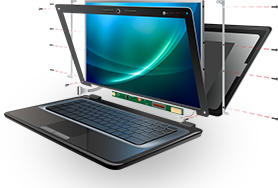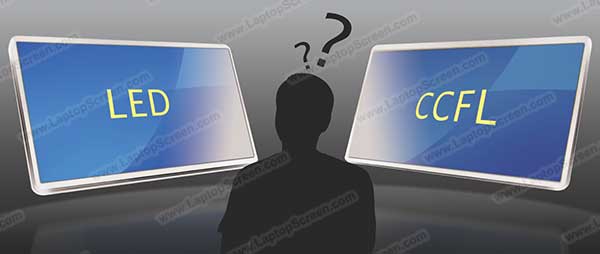In the overwhelming majority of cases our customers pick the correct LCD for their laptop and have a very pleasant LCD replacing experience.
Laptops and LCDs come in myriads of models and configurations and in order to pick the correct LCD the following points have to be considered:
By far the most overlooked aspect of screen replacement is the fact that several thousands of models of laptops, which were typically released between 2007 and 2012, were part of the transitional period of two key backlighting technologies which are not easily interchangeable. At the time of writing (second half of 2013) most computers are released with LED backlights – they are backlit with an array of Light Emitting Diodes. LED technology came to replace the previously used CCFL technology which utilizes Cold Cathode Fluorescent Tube as the main source of backlight. Because of the transition many laptops would have shipped with either LED or CCFL displays, therefore it is important to be aware of these two incompatible options when making a selection for your 2007-2012 laptop.
Our site is configured to display all available options that have shipped with the laptop, and as such the listings for laptops which came with more than one backlight technology will contain items that use both LED and CCFL backlight. It is very important to know the exact backlight type your computer uses. This information can be found in spec sheets and manuals, but we find that even those are sometimes inconsistent or plain wrong, so we highly recommend verifying the original screen by actually looking at it from the back and comparing it to the pictures listed on our site.
Another commonly overlooked fact is that touch-screens, pen inputs (drawing tablet type), glass bezels and covers are not part of the LCD. Liquid Crystal Display has typically only one function – displaying visual images. Keep in mind that If your laptop comes with touch functionality, pen detection or it covered by “edge to edge” glass, replacing the LCD by itself may not resolve the issue. Typical touchscreen / glass bezel is overlaid on top of the LCD and is considered to be an independent device, not directly related to the LCD (except for it’s immediate vicinity)
In certain cases we may offer entire “top covers” / “back covers”; these contain an LCD itself as well as the appropriate peripherals like a web camera, microphone, Wi-Fi & BlueTooth antennas, bezels, hinges, touch-screens, fingerprint sensors, e.t.c.
But in all cases where the LCD is shown and the description says “LCD panel” you are most likely to receive the LCD module alone and no extra accessories. Please be extra sure of what is actually broken before ordering a display.
And lastly, a word about our prices: we offer the most competitive market prices. Your LCD selection should not be affected by the price of the part. If you pick a cheaper but incompatible part, your perceived savings will quickly evaporate as you are faced with returning the unneeded part and re-ordering the proper one. Looking at pictures and specs will guarantee a proper selection, price should only be a consideration once the type and spec of LCD has been determined.
Copyright (©) LaptopScreen.com


I do not need a new screen, but the frame around the screen for my laptop. Gateway New90. Can you help?
@Ashley, the frame is called “bezel”, and your best bet is used on eBay.
You may have to get the entire “top cover” / “back cover” / “display assembly” – since bezels are not typically sold on their own.
Hi;
I have a question about LG display : the difference between LP101WX1-SLN2 and LP101WX1-SLB1 ? From the connector pinout it seems to me that the SLB1 has integrated USB i/f for the touch screen digitizer. Do you offer the SLB1 with the capacitive touch screen as well or just only the LCD ? If only the LCD then do you have to provide additional i/f for digitizer board for touch screen using USB signals and +5V/GND from the connector ?
Thanks;
huicua
https://www.laptopscreen.com/English/screen-part-number/LP101WX1(SL)(B1)/
We only provide the touch-screen glass for Dell Latitude ST with that model of a screen.
Some options are provided with just the digitizer board.
It’s best to order by your exact LCD model number.
If only the digitizer is required, it’s best to order the digitizer by the model number of your device (tablet, computer)
Pingback: Why Don’t I Just Replace The Entire Laptop? | Blog.LaptopScreen.com
Pingback: 15.6″ AND 16.0″ IN TOSHIBA AND HP LAPTOPS | Blog.LaptopScreen.com
Pingback: IS MY SCREEN LED OR LCD? | Blog.LaptopScreen.com
Pingback: Does my screen come with an inverter? | Blog.LaptopScreen.com
Pingback: HOW TO FIND YOUR SCREEN RESOLUTION | Blog.LaptopScreen.com
Hello, I am one of those people who are allergic to the 21st century and I find it very difficult to be around LED light of any kind. I wanted to know if there is any way to replace an LCD/LED screen with an LCD/CCFL. I have an old IBM Thinkpad that, I believe, has an LCD CCFL screen and I love it, but unfortunately it can’t be updated anymore. Are there any laptops, preferably, that have the screens with no LED lighting?
Hi! Great question. The root cause of such concerns is not primarily with the LED technology itself, but its by-product of the cheap(er) back-light controllers: Flicker.
CCFL laptops are now at-least 10 years old, and the typical life expectancy of CCFL is 10 years, after which the tube starts losing brightness and may develop a pink tinge, common on older ThinkPads. It would not be advisable to purchase any CCFL tech in 2020, as it won’t last long.
Flicker of the LEDs come from the way they are “driven” (operated). LED brightness is controlled by Pulse Width Modulation (PWM) which turns the LED on and off several times per second. The final brightness will depend on how much time the LED stays on in any given second. High frequency pulses are harder to notice than low-frequency pulses, but lower frequency is cheaper to implement in electronic components. Higher end LED screens can operate at such high PWM frequencies that they are branded “flicker-free” – even the most sensitive users cannot feel anything wrong with them.
This website https://www.tftcentral.co.uk/articles/flicker_free_database.htm has catered to the sufferers of PWM flicker for a long time now, there you can find tests and listings for monitors that have been deemed acceptable. If you are looking for a new laptop, we would recommend to look for ones that use high end screens that have “IPS” technology and also provide high refresh rates 120 Hz+. Those aren’t specs directly related to PWM backlighting, but a general rule fo thumb is that high-end screens have high-end PWM drivers, which create less flicker and thus less headache and eye strain.
Another very common but almost completely unaddressed topic of why LED screens can make your eyes hurt is the default brightness. The maximum brightness you should expose your eyes to continuously is 120 nits. Most modern monitors boast 250+ and 500+ are not uncommon. You need to operate those at half or quarter brightness to keep your eyes safe. You can measure and calibrate any display by using an external colorimeter tool like this: https://www.amazon.com/X-Rite-EODISSTU-i1Display-Studio/dp/B07X8PDBFG
To summarize: a high-end graphics monitor with IPS technology and high refresh rate + hardware calibrator = optimal eye load even for sensitive eyes.
I have a question please. My screen model is B156XTK01.0 and H/W:2 and F/W:1
But i ordered the same model B156XTK01.0 but with H/W:1A
Hope there is no problem with this
Hope the laptop won’t damage the screen because of the H/W difference
Hello,
H/W:1A and H/W:2A are the same compatibility.